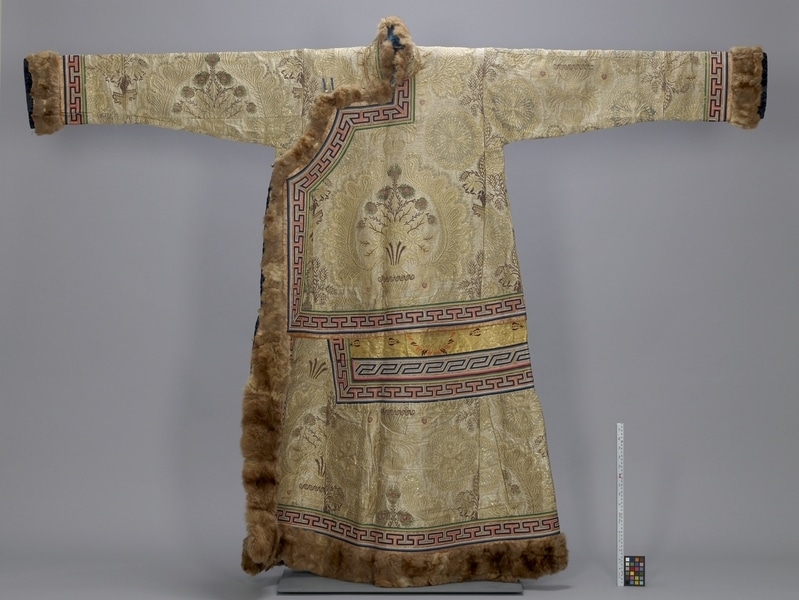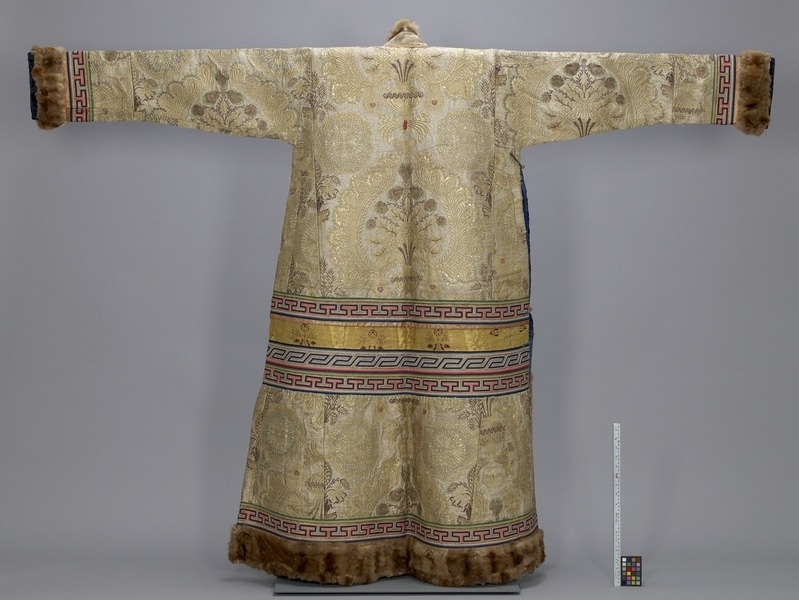Robe Item Number: 1022/1 from the MOA: University of British Columbia


Description
Lavishly embellished robe, made from light beige heavy silk brocade fabric, woven with silver and gold metallic threads, incorporating floral motifs and roundels. The brocade has been cut and pieced to create a symmetrical placement of the motifs. The robe has long, straight sleeves and mandarin collar. The robe closes asymmetrically in the front (left over right), with buttons and loops at the neck at centre front, at the upper chest on the right side, under the right sleeve and at the waist side seam. All edges (neck, front, hem and cuffs) are trimmed with brightly coloured, finely embroidered and soft brown fur. Two rows of brightly coloured, finely embroidered bands encircle the robe at hip level. The robe is very heavy, long and voluminous. Lined with bright blue and turquoise silk damask textiles.
History Of Use
The khakhazouk is a special New Year's festival coat worn as an outer garment by the upper ranks of male Tibetan aristocracy. There were said to be only 3-4 of these robes in Tibet, so that when a man had to attend that ceremony, they would have to borrow the robe from a family that had one. The robe is made from gold and silver eighteenth-century Russian brocade. Its multicoloured trim was created with very fine hand stitching, and the robe is edged with animal fur. The robe would have been worn with a fur collar lined with red brocade. Research suggests that this robe was manufactured in Russia for the Tibetan market and may date from the later 19th century.
Iconographic Meaning
The fabric, a metal enriched compound brocade, imitates in pattern 18th century European silks.
Narrative
Yapshi-Yuthok Kalon Tashi Dhondup Collection: The title Yapshi is given to all families that have a Dalai Lama born into the family, and Shape and Kalon are titles that the four lay Cabinet Ministers hold. The Yuthok family is descended from the 10th Dalai Lama, Tsultrim Gyatso. Being a Minister in the Traditional Tibetan Government, Yapshi-Yuthok Tashi Dhondup was also known as Shape or Kalon Yuthok. There is one item belonging to Kalon Yuthok that is in the collection of the Metropolitan Museum: a Tibetan saddle, which he used on special occasions and during the Tibetan New Year when he would go to the Potala Palace. It was the wish of the late Mrs. Tsering Dolkar Yapshi-Yuthok that the museum display the family's heirloom textiles so that visitors could learn about Tibet's rich history and culture.
Item History
- Made in Tibet during 1850
- Owned by Yuthok Family before January 21, 1985
- Received from Fyfe-Smith Memorial Oriental Collection Fund (Funding source) and Yuthok Family (Seller) on January 21, 1985
What
- Name
- Robe
- Identification Number
- 1022/1
- Type of Item
- robe
- Material
- silk fibre, metal, animal skin and dye
- Overall
- height 155.0 cm, width 207.5 cm
Who
- Culture
- Tibetan
- Previous Owner
- Yuthok Family
- Received from
- Fyfe-Smith Memorial Oriental Collection Fund (Funding source) and Yuthok Family (Seller)
Where
- Holding Institution
- MOA: University of British Columbia
- Made in
- Tibet
When
- Creation Date
- during 1850
- Ownership Date
- before January 21, 1985
- Acquisition Date
- on January 21, 1985
Other
- Item Classes
- textiles
- Condition
- good
- Accession Number
- 1022/0001